Patient and Family Engagement in the Emergency Department
Slide Presentation
Slide 1
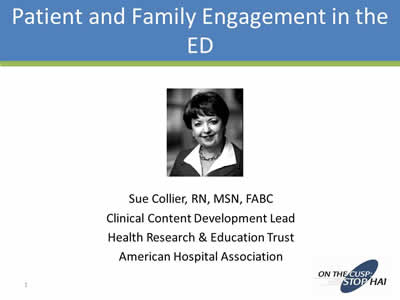
Patient and Family Engagement in the ED
Sue Collier, RN, MSN, FABC
Clinical Content Development Lead
Health Research & Education Trust
American Hospital Association
Image: Photo of Sue Collier, RN.
Slide 2
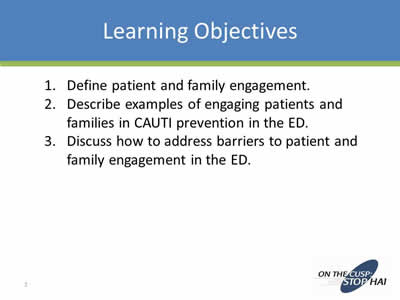
Learning Objectives
- Define patient and family engagement.
- Describe examples of engaging patients and families in CAUTI prevention in the ED.
- Discuss how to address barriers to patient and family engagement in the ED.
Slide 3
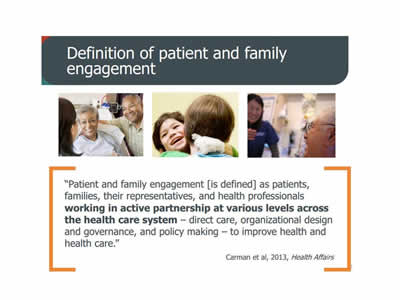
Definition of Patient and Family Engagement
"Patient and family engagement [is defined] as patients, families, their representatives, and health professionals working in active partnership at various levels across the health care system - direct care, organizational design, and governance, and policy making - to improve health and health care."
—Carman et al, 2013, Health Affairs
Images: Three photos of patients, their families, and health professionals interacting.
Slide 4
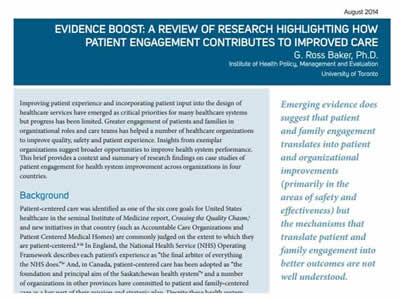
Image: Screen shot of the top of the journal article titled "Evidence Boost: A Review of Research Highlighting How Patient Engagement Contributes to Improved Care" by Gg. Ross Baker, Ph.D. August 2014.
Slide 5
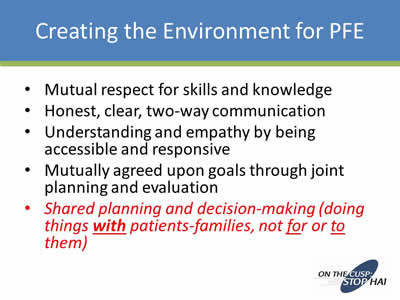
Creating the Environment for PFE
- Mutual respect for skills and knowledge
- Honest, clear, two-way communication
- Understanding and empathy by being accessible and responsive
- Mutually agreed upon goals through joint planning and evaluation
- Shared planning and decision-making (doing things with patients-families, not for or to them)
Slide 6
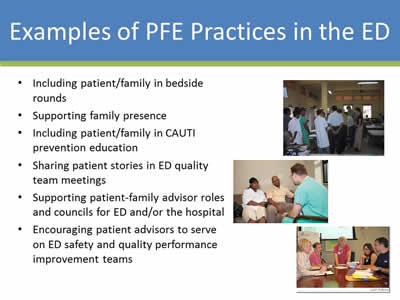
Examples of PFE Practices in the ED
- Including patient/family in bedside rounds
- Supporting family presence
- Including patient/family in CAUTI prevention education
- Sharing patient stories in ED quality team meetings
- Supporting patient-family advisor roles and councils for ED and/or the hospital
- Encouraging patient advisors to serve on ED safety and quality performance improvement teams
Images: Three photos of families and health professionals meeting.
Slide 7
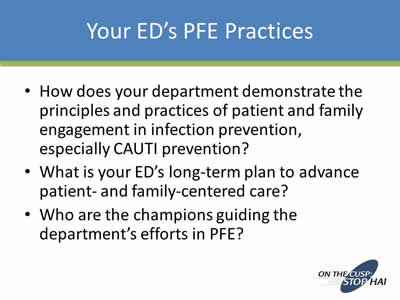
Your ED’s PFE Practices
- How does your department demonstrate the principles and practices of patient and family engagement in infection prevention, especially CAUTI prevention?
- What is your ED’s long-term plan to advance patient- and family-centered care?
- Who are the champions guiding the department’s efforts in PFE?
Slide 8
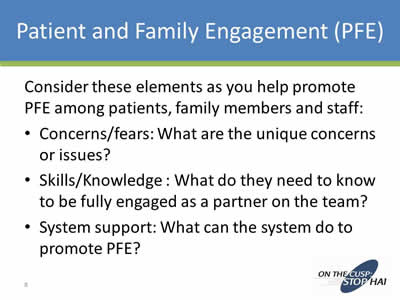
Patient and Family Engagement (PFE)
Consider these elements as you help promote PFE among patients, family members and staff:
- Concerns/fears: What are the unique concerns or issues?
- Skills/Knowledge : What do they need to know to be fully engaged as a partner on the team?
- System support: What can the system do to promote PFE?
Slide 9
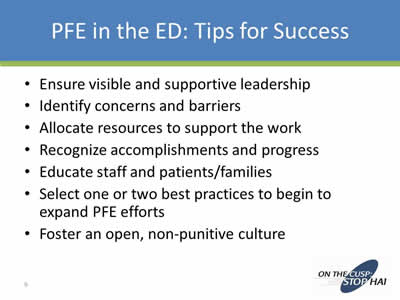
PFE in the ED: Tips for Success
- Ensure visible and supportive leadership
- Identify concerns and barriers
- Allocate resources to support the work
- Recognize accomplishments and progress
- Educate staff and patients/families
- Select one or two best practices to begin to expand PFE efforts
- Foster an open, non-punitive culture
Slide 10
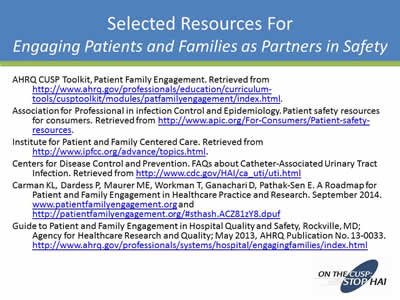
AHRQ CUSP Toolkit, Patient Family Engagement. Retrieved from /professionals/education/curriculum-tools/cusptoolkit/modules/patfamilyengagement/index.html.
Association for Professional in infection Control and Epidemiology. Patient safety resources for consumers. Retrieved from http://www.apic.org/For-Consumers/Patient-safety-resources.
Institute for Patient and Family Centered Care. Retrieved from http://www.ipfcc.org/advance/topics.html.
Centers for Disease Control and Prevention. FAQs about Catheter-Associated Urinary Tract Infection. Retrieved from http://www.cdc.gov/HAI/ca_uti/uti.html
Carman KL, Dardess P, Maurer ME, Workman T, Ganachari D, Pathak-Sen E. A Roadmap for Patient and Family Engagement in Healthcare Practice and Research. September 2014. www.patientfamilyengagement.org and http://patientfamilyengagement.org/#sthash.ACZ81zY8.dpuf
Guide to Patient and Family Engagement in Hospital Quality and Safety, Rockville, MD; Agency for Healthcare Research and Quality; May 2013, AHRQ Publication No. 13-0033. http://www.ahrq.gov/professionals/systems/hospital/engagingfamilies/index.html
Slide 11

Thank you!
Questions?
Slide 12
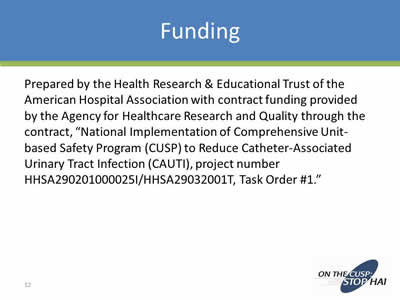
Funding
Prepared by the Health Research & Educational Trust of the American Hospital Association with contract funding provided by the Agency for Healthcare Research and Quality through the contract, “National Implementation of Comprehensive Unit-based Safety Program (CUSP) to Reduce Catheter-Associated Urinary Tract Infection (CAUTI), project number HHSA290201000025I/HHSA29032001T, Task Order #1.”
Return to CAUTI Toolkit Information for Specialty Audiences



